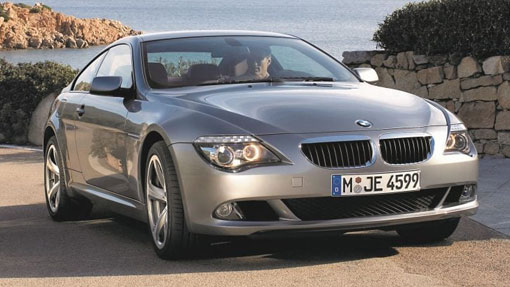BUYER’S GUIDE
BMW 6 Series E63/E64 Review
Shocking when launched, BMW’s big coupe is now maturing nicely and looks like a bargain modern classic
Engine
3.0-litre six-cylinder, petrol
Power
272PS (200kW) @ 6,700rpm
Torque
320Nm (236lb ft) @ 2,750rpm
Kerb weight
1,615kg (automatic)
0-62mph
6.4 seconds (automatic)
What Is It?
With its bustle-back and ‘flame surfaced’ panels BMW’s E63 6 Series wasn’t without controversy when it launched, though 20 years on the shock value has mellowed. While generally credited to then design boss Chris Bangle, and aligned with his ethos, accounts differ as to whether the car was his creation or that of his protégé (and current BMW design head) Adrian van Hooydonk. Whatever the truth of that the 6 Series stands as an archetypal Bangle-era BMW, its twist on classic coupe proportions and the chiselled lines still looking good.
Regular models with their choice of petrol or diesel six-cylinder or V8 petrol engines offer a mature combination of performance and luxury, the M6 meanwhile deploying its 507PS (373kW) via a high-revving V10 engine shared with the contemporary E60 M5. Whichever flavour you opt for a 6 Series today represents cracking value for money and a more soulful twist on BMW traditions than many of its more recent products, though it pays to bide your time for a good one with a solid service history to avoid some of the scarier issues.
Checklist
- This generation of 6 Series is generally distinguished by its E63 code, Convertibles officially E64s and both sharing much with the E60 generation of 5 Series
- Launched in the UK in 2004 the entire range was facelifted in 2007; in BMW jargon this is known as a Life Cycle Impulse so if you see cars advertised as ‘LCI’ this is what it refers to
- LCI cars can be identified externally by the additional strip of LEDs atop the headlight lens, different rear lights and the third brakelight relocated to the upper lip of the bootlid; other upgrades included an updated version of the iDrive infotainment system
- Engines comprise 630Ci six-cylinder petrol (renamed 630i with more power in facelift models), a twin-turbo 635d diesel, 4.5-litre 645Ci and – later – 4.8-litre 650i petrol V8s and the 5.0-litre V10 in the flagship M6
- Transmissions include a rare manual option, six-speed automatic and, on the M6, a seven-speed version of BMW’s SMG automated manual; a six-speed SMG gearbox was also available on pre-facelift 630Ci and 645Ci models
- Six-cylinder petrol cars considered reliable when looked after properly and capable of racking up big mileages with few issues; weight savings over V8s also improves handling in some eyes
- V8 engines more charismatic but suffer known issues, including oil leaks from rocker covers and failed pipes from water pumps – replacement is an engine out job and very expensive to fix
- Diesels out of favour these days but powerful; engine suits steady cruising while those with low or city miles can suffer from clogged particulate filters and other issues
- M6 engine can be very highly strung and demands diligent servicing; catastrophic failures not unknown due to dropped valves on top end and failed big end bearings; throttle bodies can also be weak
- M6 SMG gearboxes can burn through clutches if driven hard and are expensive to sort, especially if you’re replacing the flywheel at the same time; check for recent evidence of replacement and be wary of any cars that may have been abused or have been through a lot of owners in a short space of time
- Plastic sumps on automatic transmissions can warp and leak so look out for puddles under any prospective purchases
- Bodywork is generally good and mix of steel with plastic and aluminium panels means corrosion shouldn’t be an issue; if there is any rust it could indicate crash damage and poor repairs
- Bulkhead drainage channels can get blocked – check for wet carpets in footwell and beware electrical issues if water has been getting into interior; convertibles have additional rear drains that also need to be kept clear of debris
- On convertibles check condition and operation of roof and the distinctive retractable rear window
- Optional Dynamic Driving Control active anti-roll and Active Steering variable ratio rack divide opinion but add to potential complexity and things that could go wrong
How Does It Drive?
In your head you probably think of the 6 Series as a big, heavy car but even a 650i V8 weighs less than a modern-day M240i! In this context an E63 6 Series suddenly feels less intimidating, the relative simplicity of its hydraulic power steering and early-2000s running gear looking rather appealing. True, active anti-roll and variable ratio steering were on the options menu but are probably better avoided unless you crave the technical gimmickry. Because, at heart, the 6 Series strikes a nice balance between grown-up GT and the kind of sporty BMW handling we’ve all grown up with.
The later six-cylinder cars with their 272PS (200kW) output aren’t to be sniffed at and are actually relatively light on their feet, the V8s nicely charismatic and understressed while – if not fashionable – the diesels also pull strongly and will guzzle up the miles. The M6 is a different beast altogether, BMW claiming somewhat optimistically at launch it had the chops to rival anything from Aston Martin, Ferrari or Lamborghini. That may be pushing it somewhat but the high-revving V10 is a naturally aspirated masterpiece, and with the limiter removed it’s a genuine 200mph-plus car brimming with character.
What’s Good?
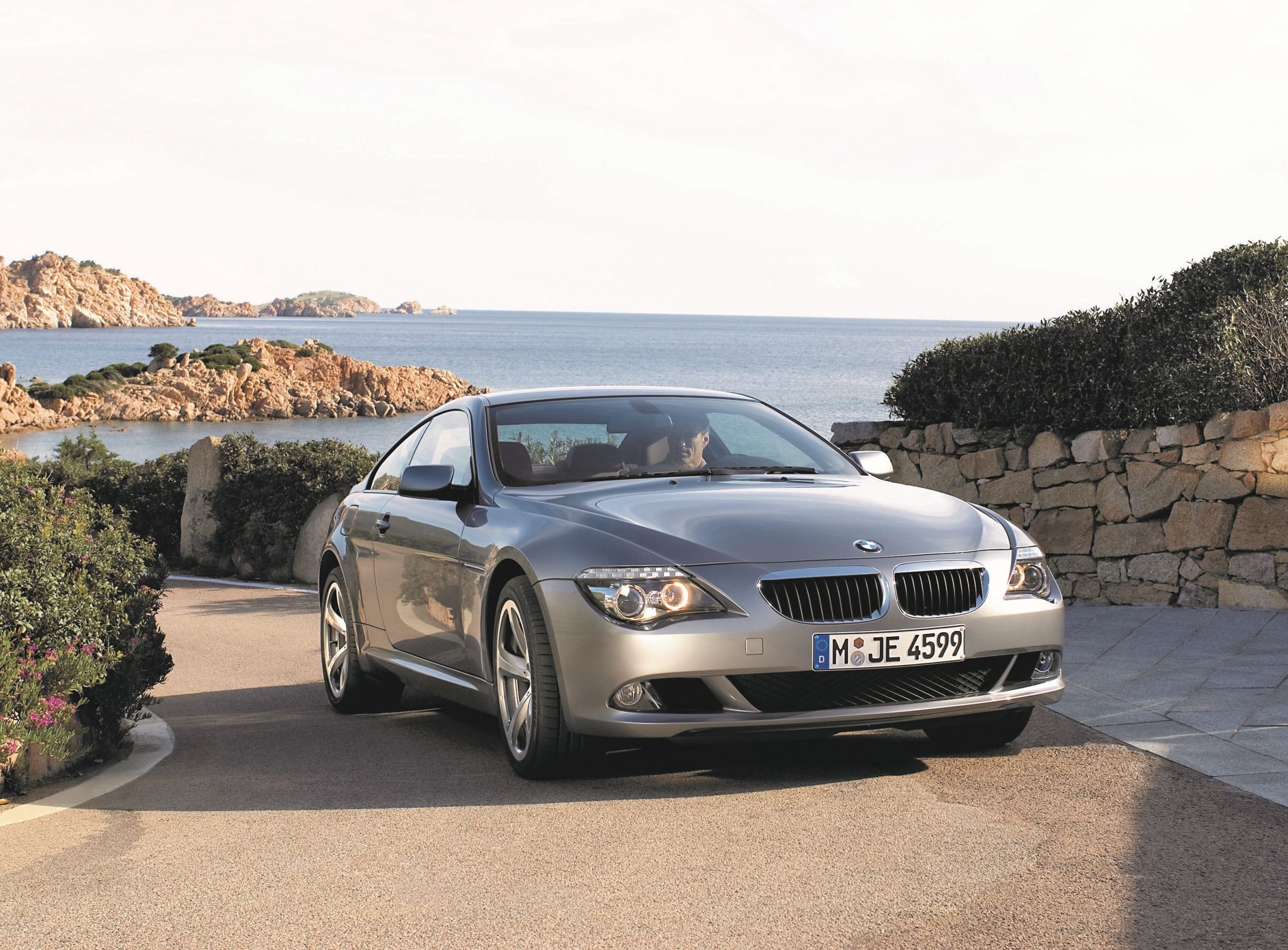
Expensive BMWs have always suffered pretty hefty depreciation, the 6 Series especially hard on the original owners in this respect. A few years down the line the flipside is a potential bargain for canny used buyers, the unfashionable offering of diesel power or relatively thirsty petrol engines further damning it in the eyes of mainstream punters. Their loss could be your gain, and a 6 Series is a big tick against the classic ‘lot of car for the money’ promise. There’s no shame in falling for the very obvious temptations of the M6 but these are more expensive to buy and run, while the regular 6 Series offers classy and luxurious transport with looks that get more attractive with every passing year. If somewhat cramped as a family car there are token rear seats to share the fun with the kids and a decent boot as well, so if you’re looking for stylish transport for two and something a bit different for living the coupe dream it’s an appealingly understated choice that would still look good pulling up outside that trendy boutique hotel.
What’s Bad?
Having lingered for some time at the lowest point of a rather epic depreciation curve it’s safe to say many 6 Series will have fallen into the hands of owners more interested in the pose than keeping up with the maintenance required of a car of this type. Which could come to bite you expensively on the backside if you end up with a car that hasn’t been looked after properly. The warning signs should be obvious enough and if you find one on cheap mismatched tyres with a V5 that’s been around the block a few times you should probably hold out for another with a more salubrious history. This counts for double with the M6, given the highly-stressed engine and gearbox don’t respond kindly to abuse and are viewed by some in the trade as an expensive grenade with the pin well and truly pulled. As with any aging luxury car the complexity of the many and various onboard kit will also be a concern, the controversial iDrive system perhaps better than it was considered at the time but still dating the 6 Series in onboard tech terms.
Which Model To Choose?
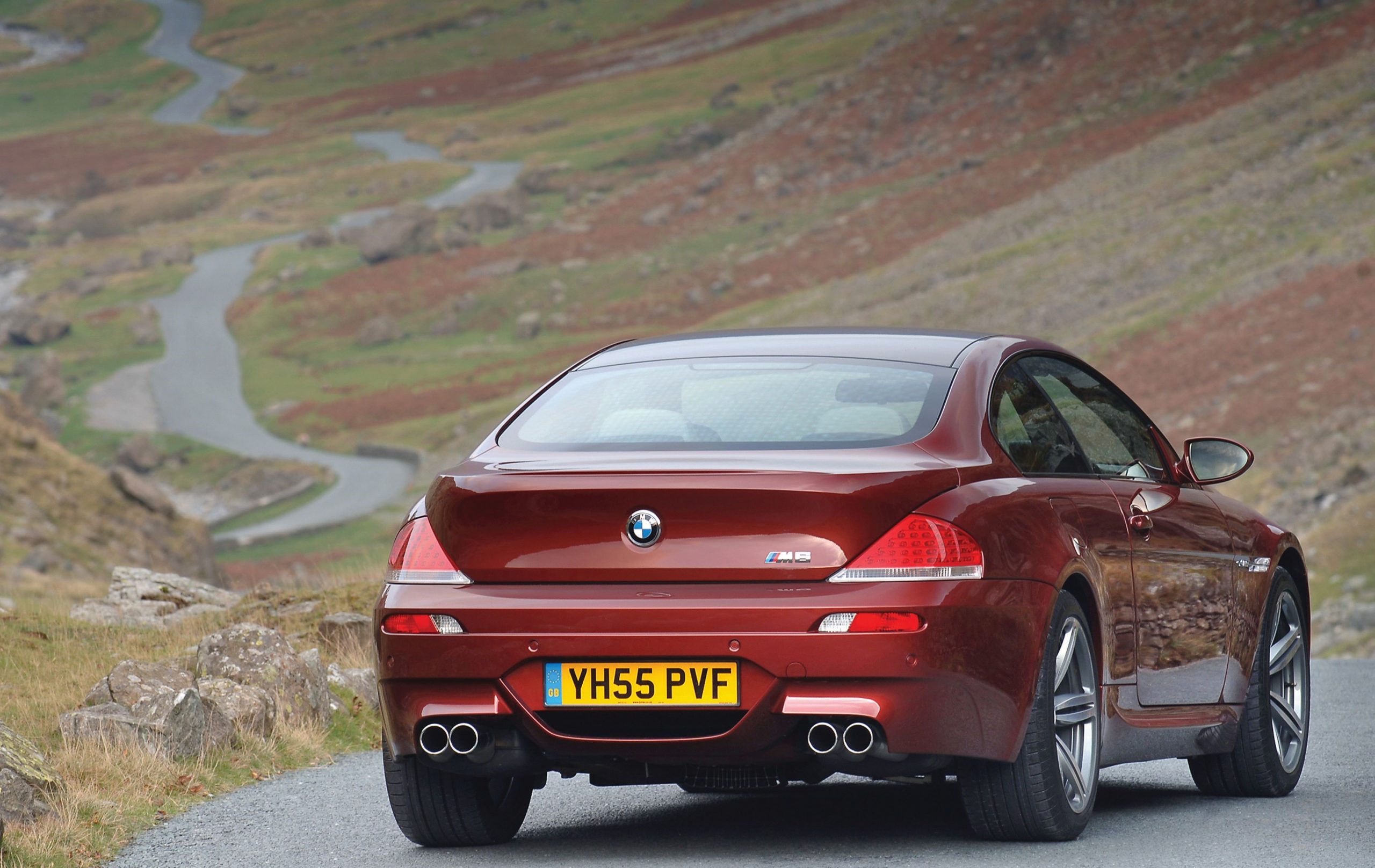
With that engine and performance that still looks pretty mighty in a modern context there’s undeniable appeal in the M6, and we’d applaud anyone willing to take the plunge given the potential for it to go very expensively wrong. If not perhaps the supercar beater BMW hoped it’s certainly a charismatic and defiantly different alternative to that 911, too. Back on planet earth the silky appeal of V8s is hard to ignore, and the big engine vibe certainly suits the grown-up ambience. The Convertible is a stylish option, the buttressed roof and retractable rear screen adding quirky appeal. But the coupe looks less bother over the long-term. And buying with the head rather than the heart a post-facelift 630i could be the smart choice. 272PS (200kW) is enough to be going on with, the fact it weighs 110kg less than an equivalent 650i meaning it arguably handles with a bit more verve as well. The classic combination of a silky straight-six in a posh BMW coupe has old-school appeal as well, the significant savings in running costs the icing on the cake.
Specifications
Engine
3.0-litre six-cylinder, petrol
Power
272PS (200kW) @ 6,700rpm
Torque
320Nm (236lb ft) @ 2,750rpm
Transmission
Six-speed automatic, rear-wheel drive
Kerb weight
1,615kg (automatic)
0-62mph
6.4 seconds
Top speed
155mph
Production dates
2003-2011
Get an online quote in minutes or call us
Monday to Friday from 09:00 - 19:00
Saturday from 09:00 - 14:00
Sunday from 10:00 - 14:00
or Arrange a call back.
Get an Online Quote Now
Arrange a Call Back
win a year's car insurance
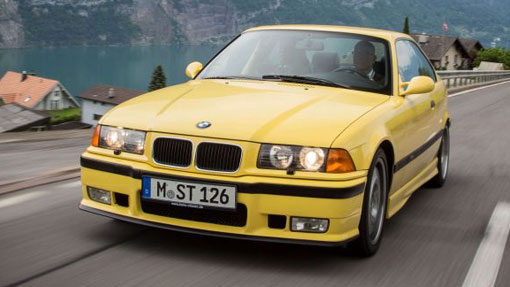
BMW M3 (E36)
BUYER’S GUIDE
BMW M3 (E36) Review
The moment the BMW M3 grew up and got sensible, the E36 is finally getting the recognition it deserves and makes a great modern classic
Engine
3.2-litre six-cylinder, petrol
Power
321PS (236kW) @ 7,400rpm
Torque
350Nm (258lb ft) @ 3,250rpm
Kerb weight
1,515kg
0-62mph
5.5 seconds
What Is It?
The arrival of the E36 BMW M3 in 1992 was a big emotional shift, signifying a decisive step away from the four-cylinder buzzbox vibe of the original and to a more mature and rounded vehicle closer in spirit to the M3 of today. The switch to a beefy straight-six was fundamental to this change in character, and was accompanied by new M3 variants like a four-door saloon and, later, the first appearance of the SMG automated manual gearbox. For some the increase in weight, technology and refinement were a step in the wrong direction and the E36 was for a long time underappreciated, though things are now coming full circle and its status as a true M car is now recognised and increasingly valued. For all the more grown-up vibe this is still, by modern standards, a raw and exciting car, with performance that’s perhaps easier to appreciate on modern roads than its newer relatives.
Corrosive Areas
Jacking points
Rear suspension mounts
Boot floor
Checklist
- E36 M3 development basically comprises two generations, starting with the 286PS (210kW) 3.0-litre original in 1992 and then the 321PS (236kW) 3.2-litre ‘Evo’ from 1995
- Facelift Evo models easily distinguishable by clear indicator lenses, though some earlier cars may have had these retrofitted
- Engines are known respectively as the S50B30 and S50B32 and share common features like individual throttle bodies; the 3.0-litre features VANOS variable valve timing on the intake while the 3.2 ‘double VANOS’ features it on exhaust side as well
- The E36 M3 launched with a five-speed manual transmission, upgraded to a six-speed manual for the Evo and then joined shortly after by the six-speed SMG automated manual gearbox
- Four-door saloon (or ‘limousine’ by BMW’s official designation) and a convertible version joined the range in 1994
- Limited editions include the left-hand drive only homologation M3 GT with its signature British Racing Green paint, bigger front splitter and rear spoiler, ‘aero’ mirrors, aluminium doors and carbon-trimmed interior; UK market M3 GT Individual adopted a similar look but not the uprated 296PS (218kW) power output or aluminium doors (in most cases); run-out edition of 50 M3 Imola Individuals sold in UK with GT bodykit, Imola Red paint and other detail upgrades
- Engines are generally considered tough when looked after properly so look for evidence of proper care; VANOS system can fail on 3.0 and 3.2 engines so check for a rattly top end, rough idling and low-rev lethargy
- Other mechanical weak spots include the drive sprocket for the oil pump (check the single nut holding it is secure) while the water pump is a known failure point; check all pipework and seals for leaks as well
- Manual transmissions can suffer abuse in hard-driven examples; SMG automated manual can throw up faults and adds complexity, commonly shown as an error light on the dash and refusal to select neutral; repairs can be costly
- Exhausts can crack and are expensive, likewise catalytic converters
- Check thoroughly for rust, especially around the jacking points, inner front wings, rear wheelarches, rear damper top mounts, rear trailing arm mounts, boot floor and upper windscreen edge
- Sloppy response can be attributed to worn engine mounts, suspension bushings and links; most are service parts but changing the rear trailing arm bushings is a specialist job
- Power steering racks can leak or fail; retrofit units from the Z3 a potential upgrade offering faster rack and improved response
How Does It Drive?
The character of the E36 M3 is, inevitably, very different from that of its more frantic predecessor given the extra cylinders, kilos and luxuries. But, looking back to where M started, it’s more like a junior M5 in its combination of understated muscularity, stirring performance and luxury. That engine is still pretty special, too, and at just shy of the magic 100PS per litre had better specific output than even the Italian exotica of the era. Which isn’t bad in a 3 Series.
A well-sorted example should combine a creamy, six-cylinder power delivery stretching all the way out to the 7,000rpm-plus redline with sharp, precise handling and that traditional BMW rear-driven balance. If less ‘on the doorhandles’ than its E30 predecessor it’s still fast and sharp enough to keep pace with anything of similar vintage, this blend of performance and refinement as attractive now as it was then. While most will prefer the manual the automated SMG seems an increasingly interesting curio for those willing to apply themselves to driving it properly, the need to lift between shifts offering a more involving two-pedal experience than the dual-clutches and autos in more recent M3s and M4s.
What’s Good?
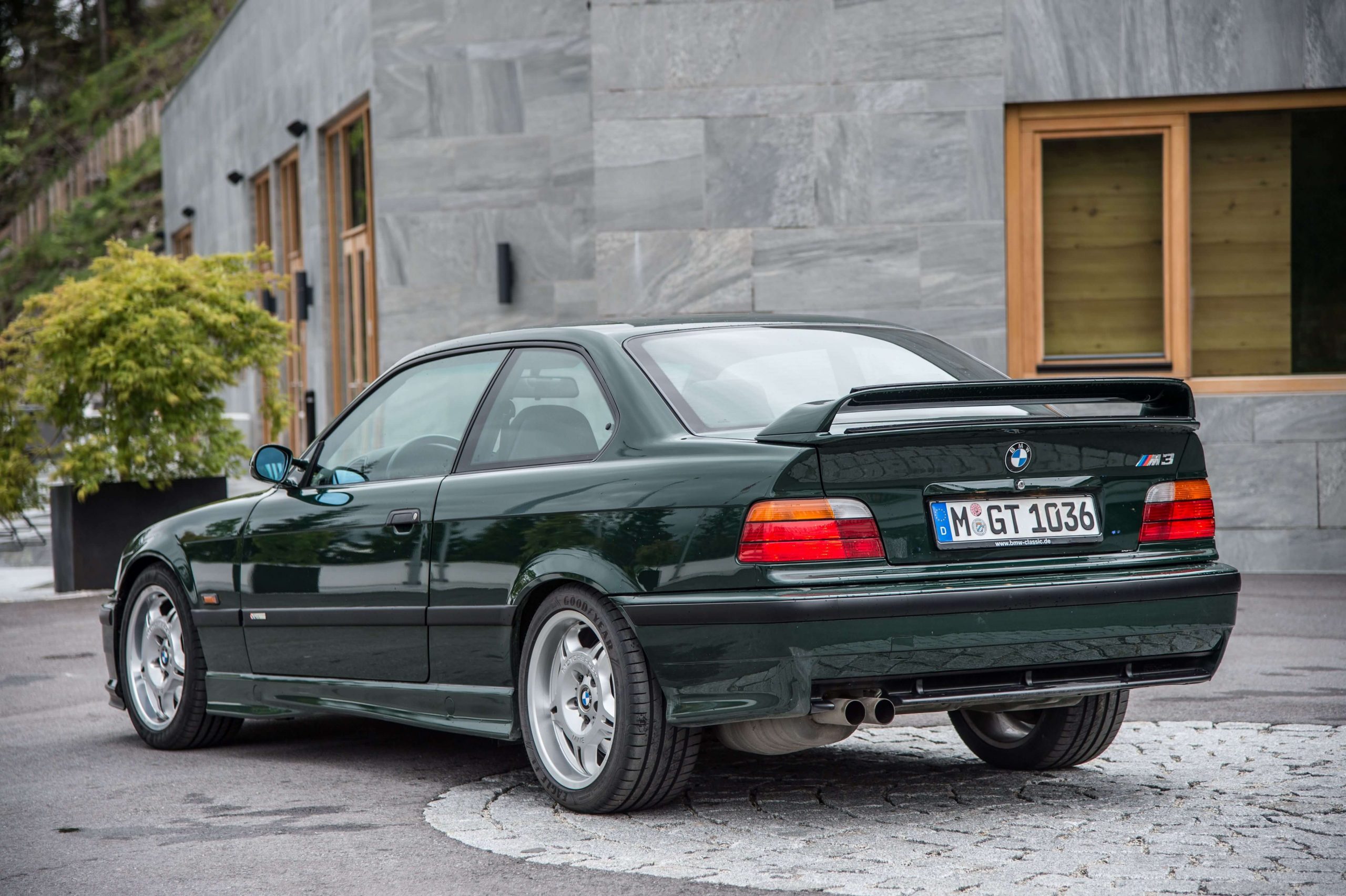
Against the gaping grille and rippling bodywork of the latest M3 and M4 the E36 is a model of aesthetic restraint, with just enough about its stance and exterior details to set it apart from regular 3 Series of the era without shouting too loudly about it. That remains a very attractive combination, with the choice to go more lairy in some of the louder colours or play the stealthier card as taste dictates. The four-door, meanwhile, has much of the same appeal in a properly understated package. All are fast but the later 3.2-litre ‘Evo’ models offer a serious step up in performance with the increase in power to well over 300PS, while the combination of performance and luxury mean it’s a nice place to rack up the miles whether you’re letting rip or just on a cruise. Inclined on its side to reveal those individual throttle bodies and breathing out via a racy tubular manifold, the big straight-six looks as good under the bonnet as it sounds as well.
What’s Bad?
While appreciation is now growing and good examples are increasing in value the E36 has, like most M3s, lived through a period of relative affordability and, therefore, accessibility for owners more interested in short-term thrills than long-term upkeep. This particular ‘buyer beware’ vigilance when choosing one, with gaps in the service history, suspiciously low mileages, signs of bodged repairs and dodgy modifications all warning signs to pay heed to. Having waded through the many on sale with one or more of these red flags only then can you apply the more diligent checks for some of the known corrosion spots or mechanical weaknesses. Meanwhile, the SMG automated manual is best described as an acquired taste and adds potential for expensive failures and the convertible, while popular with some, is heavier, softer and arguably compromised as a proper performance car. The power roof can also be expensive to fix if it goes wrong.
Which Model To Choose?
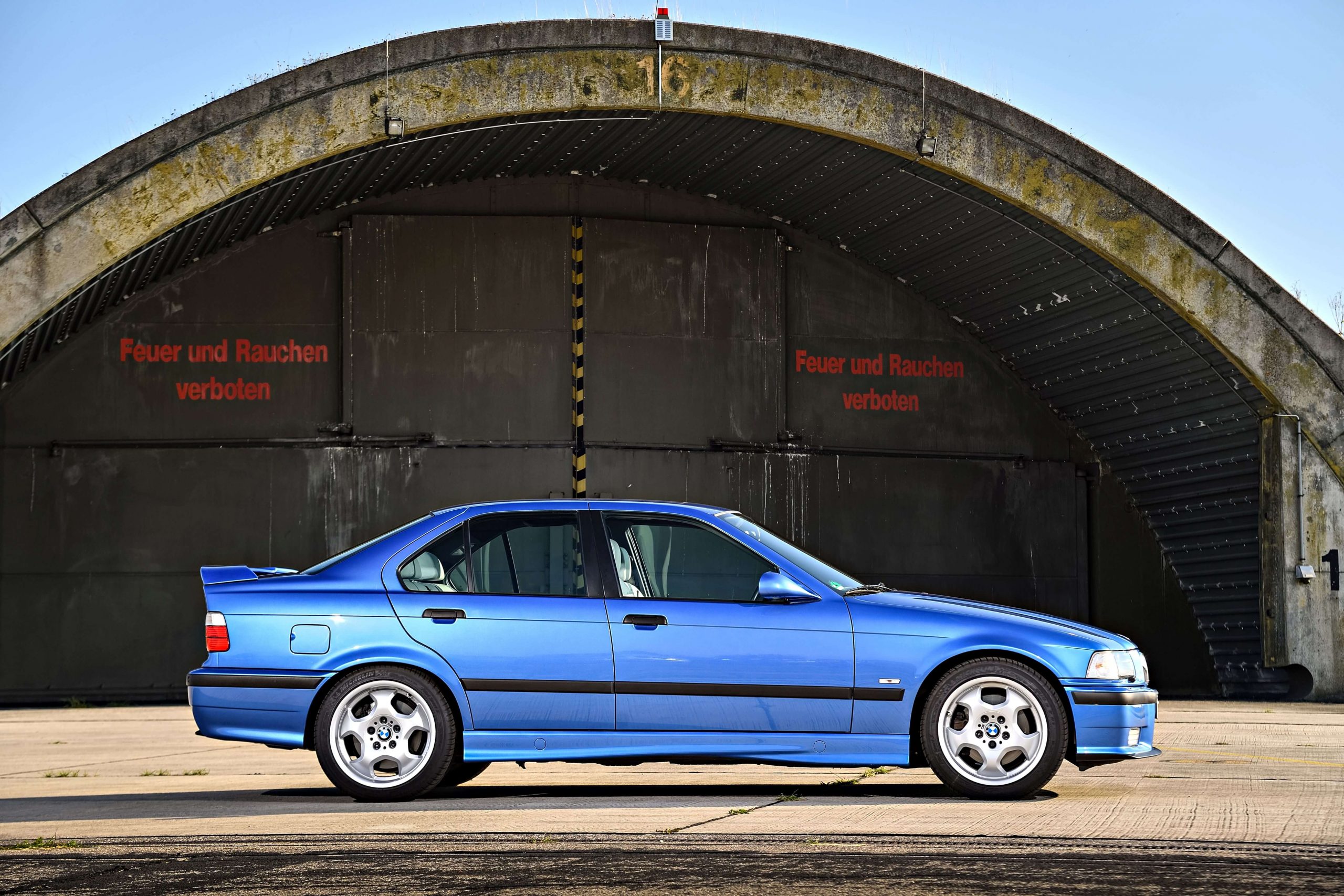
While the saloon has a certain Q-car appeal most M fans will probably gravitate towards the coupe, given its purist credentials and more distinctive looks. Pre-facelift models with the 3.0-litre engine may be usefully cheaper to buy and still have the character and performance to put a smile on your face. Collectable versions like the European-market, homologation spec GT with its 296PS (218kW) version of the 3.0-litre engine, distinctive British Racing Green paint and high-level rear wing are prized, the UK-market GT Individual getting the look if not the really juicy mods while in fact even rarer. Also prized, the run-out Imola Individual will be much coveted by the true fans and priced accordingly. As a car to enjoy, though, an Evo with the more powerful 3.2-litre engine and manual transmission is probably the best of the bunch, and a safe place to have your money while you get out and enjoy a true BMW classic.
Specifications
Engine
3.2-litre six-cylinder, petrol
Power
321PS (236kW) @ 7,400rpm
Torque
350Nm (258lb ft) @ 3,250rpm
Transmission
Six-speed manual, rear-wheel drive
Kerb weight
1,515kg
0-62mph
5.5 seconds
Top speed
155mph
Production dates
1992-1999 (total production across all versions)
Get an online quote in minutes or call us
Monday to Friday from 09:00 - 19:00
Saturday from 09:00 - 14:00
Sunday from 10:00 - 14:00
or Arrange a call back.
Get an Online Quote Now
Arrange a Call Back
win a year's car insurance
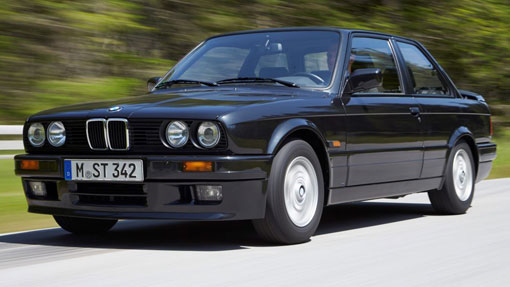
BMW 3 Series (E30)
BUYER’S GUIDE
BMW 3 Series (E30) Review
Timeless looks, stirring performance and inspiring handling guarantee the E30 BMW 3 Series top billing on the modern classics stage
Engine
2.5-litre six-cylinder, petrol
Power
170PS (125kW) @5,800rpm
Torque
222Nm (164lb ft) @ 4,300rpm
Kerb weight
1,200kg
0-62mph
8.3 seconds
What Is It?
40 years after its launch the shadow of the E30 3 Series still looms large over BMW and perhaps remains the marque’s definitive model. The simple and timeless three-box silhouette, delicate glasshouse and perfect balance of elegance and aggression were a hit in the day and remain just as popular now, while the pairing with revvy four-cylinder engines and more muscular straight-sixes meant strong performance delivered with that trademark rear-driven thrills. Joined later by convertible and then estate-bodied Touring versions, there’s an E30 to suit all tastes and the size, handling and performance remain as relevant and enjoyable now as it was back in the day. Homologation M3 versions were the icing on top of already tasty cake, these now highly sought-after and valuable in their own right.
Corrosive Areas
Windscreen lower edges and front bulkhead
Front subframe mounts and strut towers
Boot floor
Checklist
• E30 arrived in UK in 1983, with the four-door saloon following later that same year, a factory convertible from 1985 and Touring estate from 1988
• Naming conventions are relatively easy to understand, with the last two digits relating to engine capacity while the letter usually denotes fuelling – accordingly a 318i is a 1.8-litre fuel-injected version, while an ‘e’ suffix was used for economy focused models, ‘d’ was for diesel and a secondary ‘S’ (e.g. 318iS) usually means sport; the ‘x’ is the all-wheel drive version
• 320 and above are six-cylinder models
• E30 production is typically split into two phases, running from 1982 to the 1987 facelift and from here to the end of saloon production in 1990
• Touring production ran from 1988 to 1994
• 1987 facelift obvious for addition of integrated bumpers and larger rear lights, while under the bonnet the M10 four-cylinder engine was replaced by a newer generation of M40 engines and improved Motronic 1.3 engine management across the board
• Power steering was standard from 1988 onwards
• Early four-cylinder E30s may have four-speed manuals but most will feature a five-speed transmission; early autos were three-speed but, again, most will be four-speed; all options are considered reliable
• Desirable 325i Sport arrived in 1986 with stiffer Bilstein damped suspension, BBS wheels, a limited-slip differential and various trim upgrades
• Sporty 318iS featured a twin-cam 2.0-litre engine with 136PS (100kW), BBS wheels, sports seats and selected M3 trim upgrades
• Full M3 arrived in 1986 with dedicated S14 2.3-litre engine, dog-leg manual gearbox and bespoke bodywork, including shallower rear screen for improved aerodynamics; 1989 Sport Evo increased engine capacity to 2.5 litres
• S14 engine also featured in export only 318iS with 2.0-litre capacity to meet local tax threshold; left-hand drive only and rare
• Four-cylinder engines generally considered tough but both M10 and M40 can suffer top-end damage unless oil has been changed frequently so check for service history or signs of regular maintenance; M40 requires regular belt changes while the M42 version in the 318iS has a known gasket fault that can lead to coolant contamination of the oil – retrofitted engines from the later E36 3 Series are more dependable
• M20 six-cylinder engines again generally strong, though also need regular oil changes and cambelt replacements; blocks can crack so check for contaminated oil and while later Motronic 1.3 engine management can be more dependable, and can be fitted as an upgrade
• Power steering rack can leak; again retrofitted items from the later E36 can cure this while also improving steering response
• Rust can take hold anywhere and everywhere; beyond obvious corrosion to wheelarches and front wings check windscreen corners into the front bulkhead, front subframe mounts and strut towers, sills, jacking points, rear trailing arms and mounts and boot floors; sunroofs where fitted can also attract corrosion
• Square underside lifting pads often mistaken for jacking points and damaged, potentially opening door to corrosion
How Does It Drive?
Assuming the suspension, steering and tyres are all in good condition and there’s no slop or play in any of the controls any E30 3 Series should handle with that classic sporting verve BMW has made its signature. True, early 316 and 318i models don’t have a huge amount of power to exploit that but, by the time you get to the 318iS, there’s enough to be getting on with while the six-cylinder versions win on smoothness and sound. The smaller 320i and 323i combine this with a more revvy nature but the grunt of the 325i is hard to ignore, while the uprated suspension and limited-slip differential of the Sport version really make good on the promise.
Common to all E30s is the fantastic combination of compact size, an exploitable on-road footprint, fantastic visibility and the kind of driver-focused harmonisation of steering, gearshift feel and pedal response to put a smile on your face all day long. The M3, meanwhile, is a more urgent, focused expression of all of the above, the exotic homologation engine demanding revs and commitment to get its best, while the dog-leg gearbox adds to the curiosity value.
What’s Good?
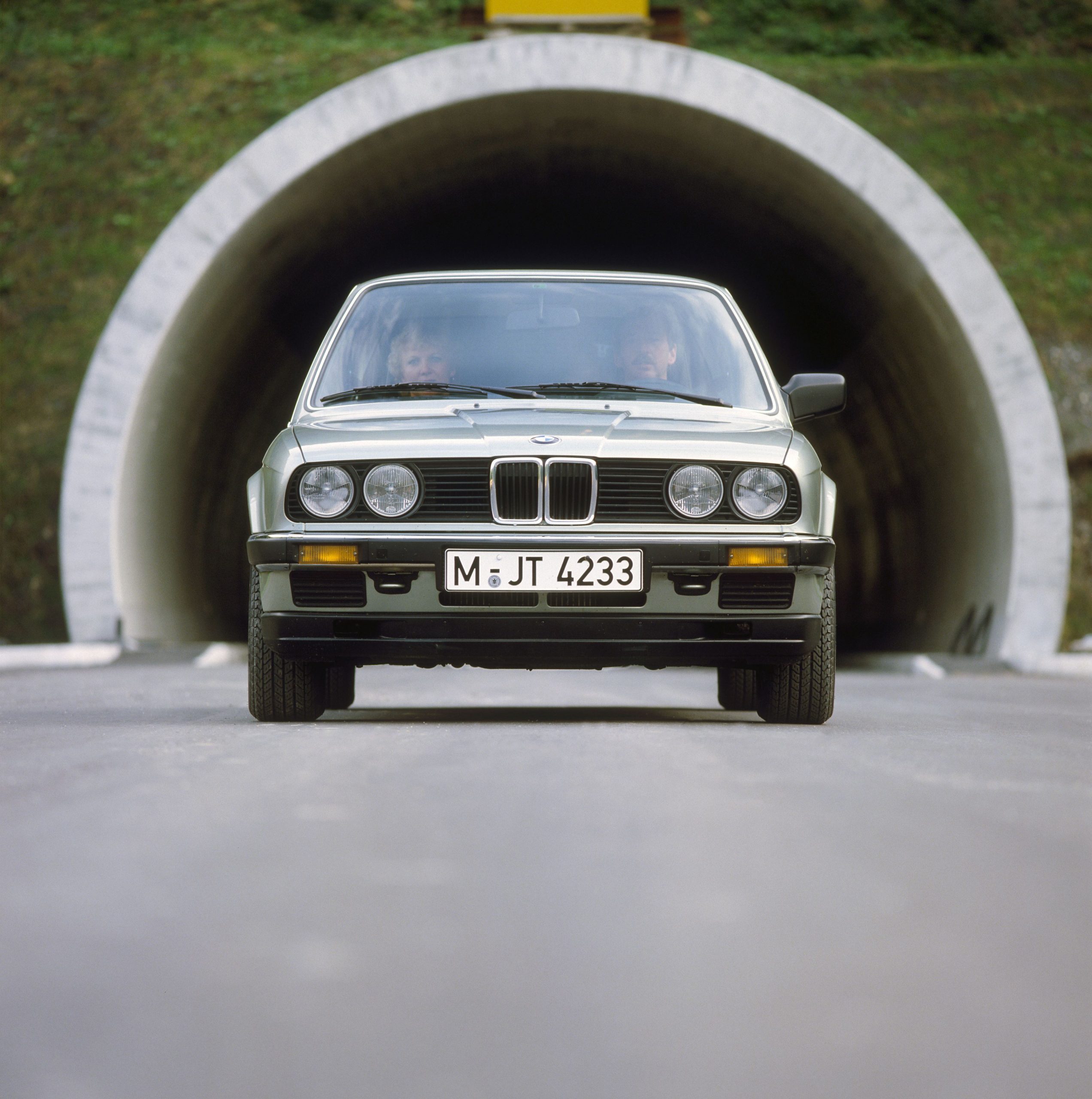
The E30 3 Series is one of those cars that looked perfect in its day and hasn’t lost any of that appeal in the decades since, such is the timeless appeal of its perfect proportions and driving manners. In three-door form it’s a genuine sporting coupe, the four-door offers much of the same with more practicality if you need it while the Touring has a style of its own. The convertible, meanwhile, offers all this with the bonus of wind in the hair fun. Enduring popularity, a passionate and knowledgeable community of owners and specialists and decent parts support helps take some of the stress out of ownership and inherent simplicity means a lot of regular maintenance is well within the capability of a competent home mechanic. Interchangeability of parts opens the door to endless tuning possibilities as well, though originality is increasingly prized as the supply of good cars dwindles.
What’s Bad?
While built to a high standard and with most mechanical issues generally fixable one way or another corrosion is going to be the thing that makes or breaks an E30 3 Series. And is the biggest trap waiting to snare those attracted by the idea of a cheap project or first classic. There are plenty of known spots to check, including the sills, inner and outer wings, boot floor, sunroof and lower windscreen edges but every potential purchase should be thoroughly inspected from nose to tail, with particular attention to any signs of bodged rust or crash repairs. Most will likely have had some work done at some point by now, but look for evidence of the quality of the workmanship and be wary of cars without a history file full of receipts. The desirability of models like the 325i Sport and 318iS has seen prices rocket, while the interchangeability of parts and popularity of tuning can make establishing originality tricky.
Which Model To Choose?
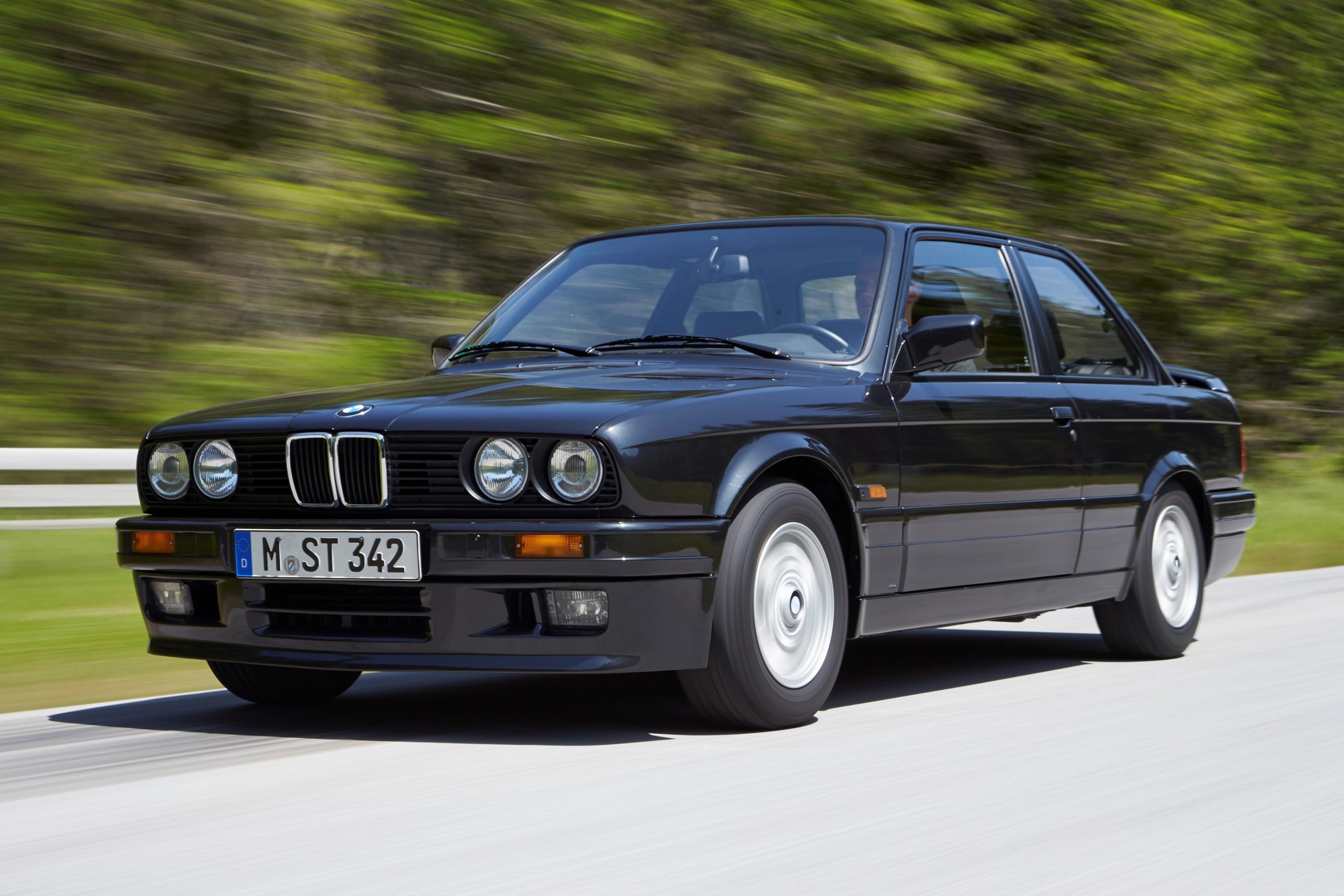
Where once under-appreciated models like the 318iS or even rare export-only 320iS may have offered a relatively affordable route into a more interesting E30 3 Series there are now few hidden gems to be uncovered. M3s operate in a sphere of their own but, inevitably, their desirability has dragged up prices of other sporting versions like the 325i Sport. Post-1987 facelift models are generally considered more desirable for their more cohesive styling and later engines, and a 318i may yet offer some stripped back fun for relatively sensible money.
The small six in the 320i would be a nice step up if you can stretch to it, while choosing a four-door over a two-door or Touring might save a bit more cash upfront. If slightly less sporty convertibles are popular and priced accordingly. Accepting these are all now properly desirable classics and priced accordingly if we had the money the a 325i Sport would be an absolute delight, a clean 318iS perhaps a close second while a more basically specced four-door with a six-cylinder perhaps the most accessible option all things relative.
Specifications
Engine
2.5-litre six-cylinder, petrol
Power
170PS (125kW) @5,800rpm
Torque
222Nm (164lb ft) @ 4,300rpm
Transmission
Five-speed manual, rear-wheel drive
Kerb weight
1,200kg
0-62mph
8.3 seconds
Top speed
132mph
Production dates
1982-1990 (total saloon production; Touring 1988-1994)
Get an online quote in minutes or call us
Monday to Friday from 09:00 - 19:00
Saturday from 09:00 - 14:00
Sunday from 10:00 - 14:00
or Arrange a call back.
Get an Online Quote Now
Arrange a Call Back
win a year's car insurance
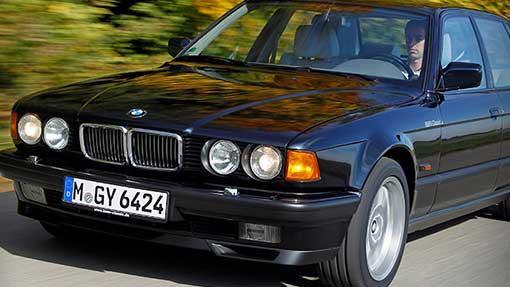
BMW E32 7 Series
BUYER’S GUIDE
BMW E32 7 Series Review
The E32 7 Series was BMW’s attempt to break out from the shadow of the Mercedes S-Class…
Manufactured
1992 to 1994
Fuel Type
Petrol
Engine Sizes
4,000cc
Engine Type
V12
Drive Configuration
RWD
What Is It?
Think ‘80s BMW and most people will immediately picture the many and various 3 and 5 Series saloons that embody the brand’s signature blend of luxury and sporting character. But the big daddy 7 Series has always had an important role showcasing the brand’s latest design, engineering and innovation.
Then as now, the Mercedes S-Class was a dominant force in this sector but, when it launched in 1986, the E32 7 Series put BMW on the front foot with its crisp, modern styling, innovations like xenon headlights and electronically controlled dampers, the offer of standard- or long-wheelbase versions and introduction of V8 and V12 engines. Often referred to with affection as ‘luxo barges’, cars of this type and vintage have a passionate following among fans of modern classics and the E32 7 Series represents the perfect intersection between traditional engineering and bold, electronically controlled future carmakers were waking up to at the time.
Literally offering a lot of car for the money, saloons of this type are an appealing choice, though not without their potential pitfalls. Here’s how to avoid falling into them.
Corrosive Areas
Rear wheel arches
Sills
Rear subframe mounts
Checklist
- Some E32s may still be running metric wheels, for which replacement tyres may be difficult to source and expensive to replace
- The 7 Series is a heavy car and puts a lot of load through its suspension so check bushings, ball joints and connections for wear and listen out for any clunks or slop
- Automatic gearboxes should shift smoothly – clonks when cycling through D to N to R could be down to worn rear subframe bushes or point to looming issues with the electronic control unit, though any number of issues can flag the dreaded ‘Trans program’ warning on the dash
- The complexity and vintage of the cars can mean rubber hoses and wiring can all fail through age and throw up any number of faults – more complex models like the 750i can be especially vulnerable here and niggles can be hard to trace and rectify
- If you’re worried about buying a V8 that may have Nikasil cylinder linings then get a compression check (or ask for evidence of the same) for evidence of damage – if it’s survived this far without damage it may be a safer bet now than it once was
- Obvious corrosion to doors, sills and wheelarches will be easy enough to spot but lift trim and carpets around the sills, boot floor, sunroof aperture and anywhere else moisture could potentially find its way into the structure and cause rust to spread from the inside out
- Electronic Damper Control was standard on the 750i and optional on the 740i – it was an attractive feature and technical talking point back in the day but is now just another thing that could go wrong, so think carefully about whether it’s worth the risk
- Whichever engine you’re looking at check carefully for fluid leaks or unusual noises that could point to poor oil circulation or other issues
How Does It Drive?
The E32 7 Series has all the attractions of a proper luxury saloon but with the sporty edge 80s BMWs were celebrated for. And offers, therefore, something a bit different from wafty, contemporary rivals like the W126 S-Class, or the Jaguar XJ40 that arrived in the same year as the E32. Think of it as a 3 Series for grown-ups and you’re halfway there.
For a model with an apparently small range the spectrum of character is actually pretty broad as well, going from the traditional six-cylinder engine and manual gearbox to a silky smooth V12 with a slick-shifting five-speed auto. With a sporty seating position and a centre console angled towards the driver in the brand’s traditional style, there are plenty of indicators the 7 Series is a limo to enjoy driving yourself. Though for those who preferred to take a back seat there was also an option of an ‘L’ badged long-wheelbase version across the range as well. By modern standards the power outputs look relatively modest, with even the 5.0-litre V12 only delivering 300PS (220kW) but doing so with dreamy smoothness and character.
Introduced later in the model’s life, the 740i with the 4.0-litre V8 and five-speed automatic gearbox is a nice balance of performance and refinement, though the well-publicised Nikasil cylinder lining issues put a lot of buyers off and, for many, the older six-cylinder cars retain a more appealing old-school vibe.
What’s Good?
Late ‘80s and early ‘90s BMW design still has an unadorned freshness about it, looking more modern than many contemporaries but with enough classic cues to draw a link to the brand’s traditions. That modernist streak runs through the E32 and, like every 7 Series that has followed, BMW was keen to show off its latest technology in this flagship model.
In keeping with the times electronic control was embraced as the answer to every luxury need, whether it be the suspension, the gearbox or the climate control while the V12 engine brought status, was the first for a German brand in the post-war era and provided a confident expression of BMW’s engineering prowess. It would later provide the basis for the engine at the heart of the mighty McLaren F1, as well as power BMW to its first and only Le Mans win to date. Mercedes responded with a V12 of its own in the aesthetically and technically imposing W140-era S-Class, and with it arguably regained its lead in the luxury limo field.
Throughout that time, though, it’s fair to say the E32 7 Series always seemed cooler, looked more elegant and retained a sportier image that set it apart from its rivals, and remains attractive to this day.
What’s Bad?
Luxury saloons of this vintage my look appealing in terms of value for money. But the E32 is now of age where the double-whammy of traditional classic car issues like corrosion overlap with more modern ones, like complex electrical systems throwing up fault codes and other problems.
Finding people with the necessary parts, expertise or inclination to solve such issues may prove challenging as well. Well-documented problems include the notorious Nikasil cylinder linings on the V8 engines that were addressed with more durable Alusil replacements on later cars, electronic control units on the automatic gearboxes failing or complex automatic climate control systems going on the blink.
Appealing as the V12 may seem it is, inevitably, a very complicated engine and requires a healthy combination of luck and budget to keep sweet. As such the early cars with the old-school ‘M30’ six-cylinder engines and less complicated support systems may prove a safer way to enjoy the E32’s considerable charms.
Which Model To Choose?
BMW’s usually straightforward model hierarchy is a little confusing with the E32 on the basis that, depending on its vintage, a 730i could be a straight-six or a V8. Other than that the progression is relatively logical, the 735i using a more powerful version of the six before being replaced by the 740i V8 while the 750i V12 sits proudly at the top of the pile.
Performance improves incrementally as you progress up the range or look to later cars but, by the numbers, isn’t wildly different. This means your decision can be driven by more important considerations like mileage, condition and – most importantly – service history.
If we were confident about the latter and satisfied any cylinder lining issues were sorted a late-model 740i with the standard, non-electronic dampers would seem the sensible middle ground of performance and modernity, though going the other way the earlier 735i compensates for its more modest performance by virtue of its proven six-cylinder.
Specifications: BMW E32 7 Series 740i
Engine
4.0-litre V8, petrol
Power
286PS (210kW) @ 5,800rpm
Torque
400Nm (295lb ft) @ 4,500rpm
Transmission
Five-speed automatic, rear-wheel drive
Kerb weight
1,790kg
0-62mph
7.4 seconds
Top speed
149mph
Production dates
1992-1994
